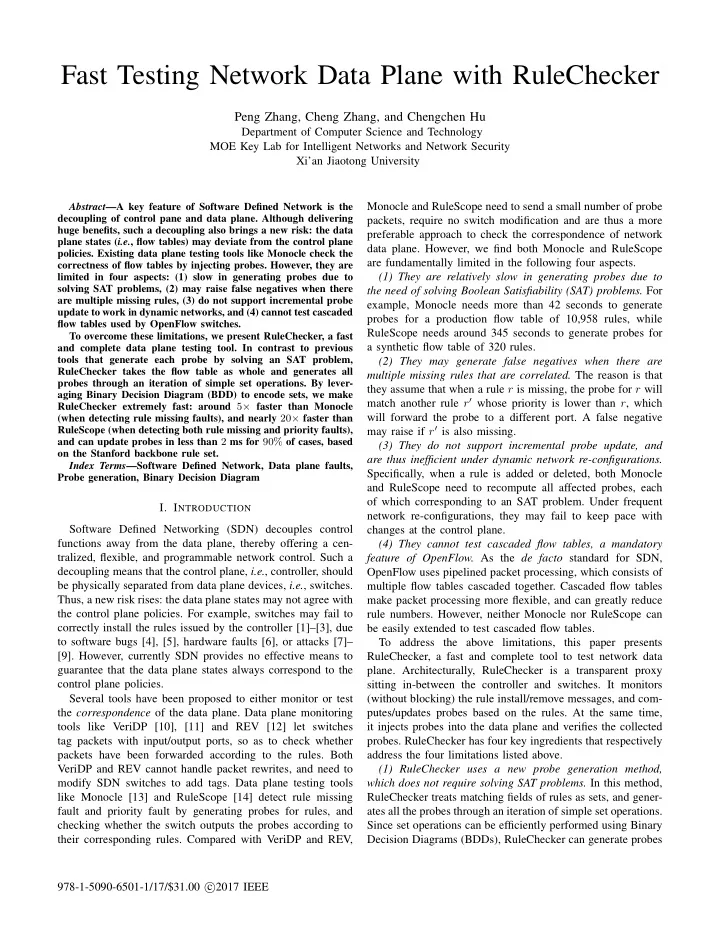

Fast Testing Network Data Plane with RuleChecker Peng Zhang, Cheng Zhang, and Chengchen Hu Department of Computer Science and Technology MOE Key Lab for Intelligent Networks and Network Security Xi’an Jiaotong University Monocle and RuleScope need to send a small number of probe Abstract —A key feature of Software Defined Network is the decoupling of control pane and data plane. Although delivering packets, require no switch modification and are thus a more huge benefits, such a decoupling also brings a new risk: the data preferable approach to check the correspondence of network plane states ( i.e. , flow tables) may deviate from the control plane data plane. However, we find both Monocle and RuleScope policies. Existing data plane testing tools like Monocle check the are fundamentally limited in the following four aspects. correctness of flow tables by injecting probes. However, they are (1) They are relatively slow in generating probes due to limited in four aspects: (1) slow in generating probes due to solving SAT problems, (2) may raise false negatives when there the need of solving Boolean Satisfiability (SAT) problems. For are multiple missing rules, (3) do not support incremental probe example, Monocle needs more than 42 seconds to generate update to work in dynamic networks, and (4) cannot test cascaded probes for a production flow table of 10,958 rules, while flow tables used by OpenFlow switches. RuleScope needs around 345 seconds to generate probes for To overcome these limitations, we present RuleChecker, a fast a synthetic flow table of 320 rules. and complete data plane testing tool. In contrast to previous tools that generate each probe by solving an SAT problem, (2) They may generate false negatives when there are RuleChecker takes the flow table as whole and generates all multiple missing rules that are correlated. The reason is that probes through an iteration of simple set operations. By lever- they assume that when a rule r is missing, the probe for r will aging Binary Decision Diagram (BDD) to encode sets, we make match another rule r ′ whose priority is lower than r , which RuleChecker extremely fast: around 5 × faster than Monocle will forward the probe to a different port. A false negative (when detecting rule missing faults), and nearly 20 × faster than may raise if r ′ is also missing. RuleScope (when detecting both rule missing and priority faults), and can update probes in less than 2 ms for 90% of cases, based (3) They do not support incremental probe update, and on the Stanford backbone rule set. are thus inefficient under dynamic network re-configurations. Index Terms —Software Defined Network, Data plane faults, Specifically, when a rule is added or deleted, both Monocle Probe generation, Binary Decision Diagram and RuleScope need to recompute all affected probes, each of which corresponding to an SAT problem. Under frequent I. I NTRODUCTION network re-configurations, they may fail to keep pace with Software Defined Networking (SDN) decouples control changes at the control plane. functions away from the data plane, thereby offering a cen- (4) They cannot test cascaded flow tables, a mandatory tralized, flexible, and programmable network control. Such a feature of OpenFlow. As the de facto standard for SDN, decoupling means that the control plane, i.e. , controller, should OpenFlow uses pipelined packet processing, which consists of be physically separated from data plane devices, i.e. , switches. multiple flow tables cascaded together. Cascaded flow tables Thus, a new risk rises: the data plane states may not agree with make packet processing more flexible, and can greatly reduce the control plane policies. For example, switches may fail to rule numbers. However, neither Monocle nor RuleScope can correctly install the rules issued by the controller [1]–[3], due be easily extended to test cascaded flow tables. to software bugs [4], [5], hardware faults [6], or attacks [7]– To address the above limitations, this paper presents [9]. However, currently SDN provides no effective means to RuleChecker, a fast and complete tool to test network data guarantee that the data plane states always correspond to the plane. Architecturally, RuleChecker is a transparent proxy control plane policies. sitting in-between the controller and switches. It monitors Several tools have been proposed to either monitor or test (without blocking) the rule install/remove messages, and com- the correspondence of the data plane. Data plane monitoring putes/updates probes based on the rules. At the same time, tools like VeriDP [10], [11] and REV [12] let switches it injects probes into the data plane and verifies the collected tag packets with input/output ports, so as to check whether probes. RuleChecker has four key ingredients that respectively packets have been forwarded according to the rules. Both address the four limitations listed above. VeriDP and REV cannot handle packet rewrites, and need to (1) RuleChecker uses a new probe generation method, modify SDN switches to add tags. Data plane testing tools which does not require solving SAT problems. In this method, like Monocle [13] and RuleScope [14] detect rule missing RuleChecker treats matching fields of rules as sets, and gener- fault and priority fault by generating probes for rules, and ates all the probes through an iteration of simple set operations. checking whether the switch outputs the probes according to Since set operations can be efficiently performed using Binary their corresponding rules. Compared with VeriDP and REV, Decision Diagrams (BDDs), RuleChecker can generate probes 978-1-5090-6501-1/17/$31.00 c � 2017 IEEE
Recommend
More recommend